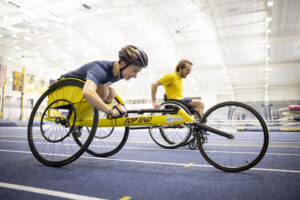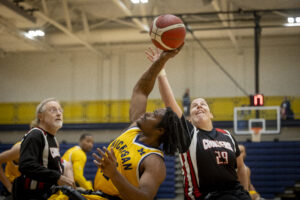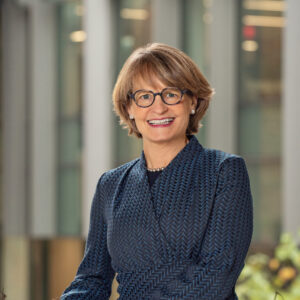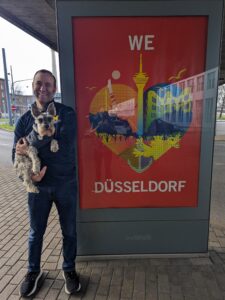
Adaptive Sports practice for Track and Field. Photo by Marc-Gregor Campredon
Sport can be a unifying language, institutionally, regionally, nationally, and internationally. The epitome of this is the way that the Olympics and Paralympics quite literally bridge the world together in celebration of sport. However, sport is not always equitably accessible to everyone, like in the case of disabled athletes. People assume “disabled-athlete” is an oxymoron and can’t exist in unison. The mission of University of Michigan Adaptive Sports & Fitness is to increase awareness, knowledge, access, and participation in adaptive sports among people with and without disabilities so that all people understand that disability is not inability.
As adaptive sports begin to receive more recognition within the University of Michigan and in the collegiate landscape, especially with Paris 2024 on the horizon, it is important to discern myth and fact in our discovery process that adaptive sports are truly for everyone. Below, the Adaptive Sports & Fitness team addresses some of the most common myths about adaptive sport.
Myth: “The Paralympics are for people that suffer from paraplegia.”
Fact: The term “Paralympic” originates from the Greek “para” (beside or alongside) and “Olympic,” signifying that the Paralympics run parallel to the Olympics. This epitomizes the coexistence and similarities of the two events. This principle guides UM’s Adaptive Sports & Fitness department (ASF), which aims to enrich student life through inclusive sports programs, both recreationally and competitively, catering to all individuals’ highest athletic aspirations at the University of Michigan.

Adaptive tennis practice. Photo by Marc-Gregor Campredon
The term “Paralympic” is often misunderstood, with many assuming “Para” comes from ones disability status. References like “Para-Olympics” or “Regular Olympics,” although not intentional, carry significant implications to the Paralympic movement. Some of these implications are a hierarchical structure within the games that assume the Olympics are at the top. Similarly, people often confuse the Paralympics with the Special Olympics, which is a separate – though no less important – movement that also serves the disability community, but is unique in its mission and goals.
The notion that one “suffers” from an injury or resulting disability can be very reductive within the disability community. Disability is not inability and we do not need to “cure” disability, rather we need to relook at how we can change structures and values that allow all people to have equitable access. This concept comes from the “social model of disability” and is a unit wide methodology that does not just guide UM Adaptive Sports & Fitness, but the entire unit of Student Accessibility and Accommodation Services (SAAS).
Myth: “Adaptive Sports are for people with disabilities.”
Fact: Adaptive sports (also known as para sports) and inclusive recreation are competitive or recreational sports for people with and without disabilities. Adaptive sports use modifications of rules or equipment that allow for equitable participation in sport by people with disabilities. Some adaptive sports are variations of existing able-bodied sports that run parallel to those sport activities (e.g. wheelchair basketball and wheelchair tennis). Some adaptive sports have been specifically designed for persons with a disability and do not have able-bodied equivalent activities (e.g. goalball).

Wheelchair Basketball with UM Adaptive Sport in Port Huron, Michigan. Photo by Marc-Gregor Campredon
Sport should be a universal language, but often people with disabilities are relegated to the sidelines due to limited access. By having inclusive adaptive sports, athletes of all abilities are given more opportunities to participate. The modification of equipment and rules in adaptive sports allow for everyone to play together; friends, family, peers, colleagues, or people in the community.
Sometimes people without disabilities are concerned that by participating in adaptive sports they are simulating disability or displacing the disabled athletes. ASF believes that through adaptive sport we can dismantle those pre-existing concerns and demonstrate that adaptive sport is a unifying experience. Simply put, adaptive sports are sports. The same way one plays pick-up basketball at the NCRB or IMSB, all are welcome to join us for drop-in wheelchair basketball. We are fortunate to have support from the University of Michigan and Student Life such that we have adaptive sports equipment for everyone to play. We have a sports chair waiting for you!
Myth: “Adaptive Sports & Fitness is a novel department at the University of Michigan.”
Fact: Adaptive Sports & Fitness officially became part of Student Life at University of Michigan in 2020 and is a relatively new movement within UM. Since its inception ASF has grown rapidly to meet the needs that exist within the UM and larger adaptive sports community.
While adaptive sports are new at University of Michigan, they are not new to the collegiate landscape. The first wheelchair basketball team (and adaptive sports program) was started in 1948 at the University of Illinois. Since then, many other institutions, approximately 20, have joined the growing collegiate adaptive sports landscape.
ASF has tried to learn from our predecessors by developing a program that includes competitive and recreational adaptive sports opportunities, community based initiatives like RX to Play, the Adaptive Sports and Inclusive Recreational Initiative, and research.
2024 was a significant landmark year in collegiate adaptive sports history with the following accomplishments resulting from the work of the institutions mentioned above, many governing bodies, and sponsor organizations like Guardian and their Adaptive Student Athlete Program.
- Wheelchair Basketball: Inclusion of a collegiate wheelchair basketball showcase at Women’s NCAA March Madness
- Wheelchair Tennis: The Intercollegiate Tennis Association formally includes collegiate wheelchair tennis as part of the governing body and includes wheelchair tennis for the first time in NCAA history at the NCAA National Championships
- Wheelchair Track: The NCAA, in partnership with with the United States Olympic and Paralympic Committee, includes wheelchair track at the outdoor national championships for this first time in history as part of the 2024 Track & Field National Championships






 Christopher R. Friese, the Elizabeth Tone Hosmer Professor of Nursing and Professor of Health Management and Policy, began his 5-year term as Vice Provost for Academic and Faculty Affairs on June 1, 2024. In partnership with Vice Provost Sara Blair, he is responsible for overseeing core faculty-centered processes, including the promotion and tenure process, as well as the Provost Office’s funding programs in support of recruiting, hiring, retaining, and promoting faculty. Friese will have oversight of the seven health science schools and the Life Sciences Institute, as well as the Ross School of Business, the Marsal School of Education, the College of Engineering, the School for Environment and Sustainability, the Law School, and the Ford School of Public Policy.
Christopher R. Friese, the Elizabeth Tone Hosmer Professor of Nursing and Professor of Health Management and Policy, began his 5-year term as Vice Provost for Academic and Faculty Affairs on June 1, 2024. In partnership with Vice Provost Sara Blair, he is responsible for overseeing core faculty-centered processes, including the promotion and tenure process, as well as the Provost Office’s funding programs in support of recruiting, hiring, retaining, and promoting faculty. Friese will have oversight of the seven health science schools and the Life Sciences Institute, as well as the Ross School of Business, the Marsal School of Education, the College of Engineering, the School for Environment and Sustainability, the Law School, and the Ford School of Public Policy.
 Ford School professor and political scientist Jenna Bednar recently joined the Office of the Provost as the faculty director of
Ford School professor and political scientist Jenna Bednar recently joined the Office of the Provost as the faculty director of